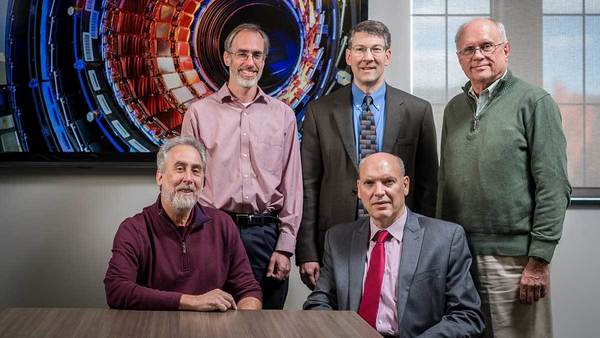
The two heaviest known particles — the Higgs boson and the top quark — have finally been linked, thanks to a discovery based on experiments at the Large Hadron Collider (LHC) at the European Organization for Nuclear Research (CERN).
Two of the particle detector experiments at the LHC detected simultaneous production of the two particles during a rare subatomic process. Several physicists from the University of Notre Dame’s Department of Physics were named as contributors to the discovery, and were aided by researchers at Notre Dame’s Center for Research Computing and the Department of Computer Science and Engineering.
Notre Dame physicists have contributed to one of the particle detector experiments, the Compact Muon Solenoid (CMS) collaboration, since construction began in 1998. Michael Hildreth, professor of physics, and Kevin Lannon, associate professor of physics, were instrumental in developing the advanced analysis techniques required to make the current definitive link between the top quark and the Higgs boson. Researchers at Notre Dame, the University of Virginia and Ohio State University began developing the first series of measurements in 2012, the year the Higgs boson was discovered.
“This link between the top quark and the Higgs boson was the next milestone in establishing Higgs properties, and is one of the flagship discoveries for the current LHC run,” Hildreth said. “And I think we have achieved it much earlier than people thought we could.”
Fundamental particles gain mass through their interaction with the Higgs field, so it would make sense that the top quark — the most massive particle ever discovered — would have a strong coupling with the Higgs boson. But scientists needed to test every aspect of the theory in order to fully verify it.
Before its discovery, theorists had a good picture of how the Higgs boson was supposed to behave, according to the Standard Model of particle physics. Now that LHC physicists can nimbly produce and study Higgs bosons, a big question remained about whether the Higgs boson could interact with quarks as predicted and, if so, what this relationship might look like.
“The Higgs boson was originally predicted because it helped explain why some force-carrying bosons had mass while others remained massless,” says Anadi Canepa, the new head of the CMS Department at Fermilab. “However, the Higgs also endows quarks with mass.”
Even though scientists suspected that the Higgs boson interacts more strongly with the massive top quark, discovered in 1995, than any other, all evidence until recently has been below the threshold required to claim a discovery. These new results — one paper accepted for publication in Physical Review Letters from the CMS collaboration and another forthcoming paper from the ATLAS collaboration — show definitively that the Higgs boson communicates with the top quark as predicted and opens up a new door to explore these interactions further.
The top quark played a key role in Higgs research even before scientists found the Higgs. Theorists used measurements of the top quark to help them narrow in on the mass of the Higgs boson prior to its discovery, and the top quark is helping physicists understand the strength of the Higgs field at different energies. The top quark also plays a huge role in Higgs boson production.
The proton-proton collisions inside the LHC produce long chain reactions that often involve multiple steps and players. These new studies focused on the rare process in which two gluons inside the colliding protons fuse and produce two virtual top quarks, which are quantum mechanical fluctuations and not yet fully formed discrete particles.
Because Higgs bosons and top quarks are short-lived particles, they almost immediately transform into more-stable daughter particles, many of which also decay. This rapid transition from one generation to the next makes it challenging — though not impossible — to retrace the lineage of the detected daughter particles back to their common ancestor.
Hildreth and Lannon worked with their students to measure the signature coupling of Higgs boson with top quarks, because particular decays have different signatures. They relied on the Center for Research Computing to generate simulated events and complete the data reduction, Hildreth said.
“This process is so rare that we needed to combine results from different Higgs signatures to maximize our sensitivity and establish the top-Higgs signal,” said Chris Neu, a physicist at the University of Virginia who worked on the CMS analysis.
The next step is to precisely measure this coupling strength and determine if it matches the predictions. Further studies will continue to explore the behavior of the Higgs boson and how it fits into the universal mosaic of matter.
“As the most massive particle we know about, the top quark really stands out. We now know the top quark’s mass definitely comes from its coupling to the Higgs boson. What we don’t understand is why the Higgs boson couples so much more strongly to top quarks than to any other type of quark,” Lannon said. “That’s the next mystery I’m interested in working to unravel.”
The research was funded by the National Science Foundation.
Sarah Charley, communication specialist at CERN, contributed to this article.
Originally published by at news.nd.edu on June 06, 2018.